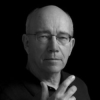Sam Abell

Sam Abell
Sam Abellis an American photographer known for his frequent publication of photographs in National Geographic. He first worked for National Geographic in 1967, and is one of the more overtly artistic photographers among his magazine peers. Sam Abell's style of photography is documentary in the sense that his major avenue, the National Geographic magazine, is a publication of record. However, his best work is known for its transcendent qualities, starting at the documentary level yet open to interpretation on an...
NationalityAmerican
ProfessionPhotographer
CountryUnited States of America
Photographs that transcend but do not deny their literal situation appeal to me.
The reason I don't want to say anything about it is it has a strange power to take over the conversation. Just like it's doing with us. I was asked to participate in a documentary about Richard Prince, and be the voice of someone who was appropriated, and I declined. The reason I did is I don't want it to be the subject of the discussion of my work.
Above all, it's hard learning to live with vivid mental images of scenes I cared for and failed to photograph. It is the edgy existence within me of these unmade images that is the only assurance that the best photographs are yet to be made.
How the visual world appears is important to me. I'm always aware of the light. I'm always aware of what I would call the 'deep composition.' Photography in the field is a process of creation, of thought and technique. But ultimately, it's an act of imaginatively seeing from within yourself.
But there is more to a fine photograph than information. We are also seeking to present an image that arouses the curiosity of the viewer or that, best of all, provokes the viewer to think-to ask a question or simply to gaze in thoughtful wonder. We know that photographs inform people. We also know that photographs move people. The photograph that does both is the one we want to see and make. It is the kind of picture that makes you want to pick up your own camera again and go to work.
I will just say, appropriation is an intellectual idea until it happens to you. It's a philosophy, and it's got its own intellectual framework. Then there's what happens when it's your photograph. Then it's personal, and that's all I'll say.
"You know you are seeing such a photograph if you say to yourself, "I could have taken that picture. I've seen such a scene before, but never like that." It is the kind of photography that relies for its strengths not on special equipment or effects but on the intensity of the photographer's seeing. It is the kind of photography in which the raw materials-light, space, and shape-are arranged in a meaningful and even universal way that gives grace to ordinary objects."
I think of myself as a writer who photographs. Images, for me, can be considered poems, short stories or essays. And I've always thought the best place for my photographs was inside books of my own creation.
Life rarely presents fully finished photographs. An image evolves, often from a single strand of visual interest - a distant horizon, a moment of light, a held expression.
[In the late 80's] that's the first time I heard about that astonishing idea [that most photographs would be taken on telephones]. And now I've been watching the tsunami of images.
My first priority when taking pictures is to achieve clarity. A good documentary photograph transmits the information of the situation with the utmost fidelity; achieving it means understanding the nuances of lighting and composition, and also remembering to keep the lenses clean and the cameras steady.
Photography, alone of the arts, seems perfected to serve the desire humans have for a moment - this very moment - to stay.
We know that photographs inform people. We also know that photographs move people. The photograph that does both is the one we want to see and make.
People say to me, "Who's your favorite kind of photographer?" Or "Who would be your favorite photographer to have in a workshop?" And I always say, "My Dad."